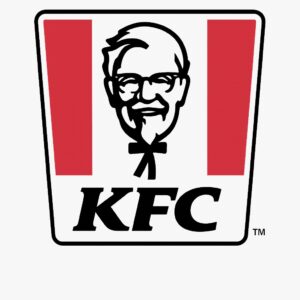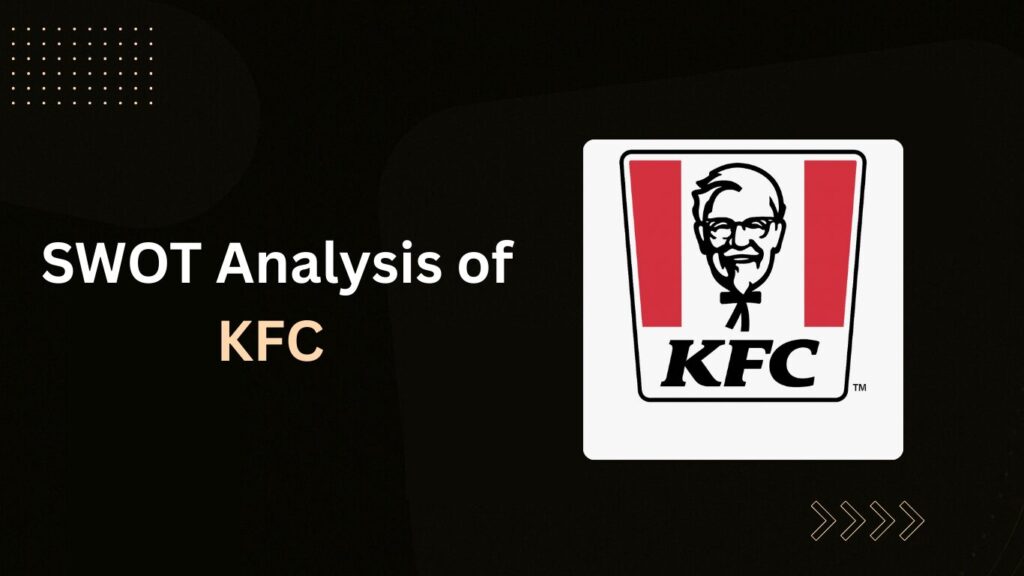KFC, short for Kentucky Fried Chicken, is one of the most recognizable fast-food brands globally, renowned for its iconic crispy chicken and the unforgettable image of Colonel Harland Sanders. Over the decades, KFC has transformed from a small roadside eatery into a global fast-food empire, captivating taste buds in over 145 countries.
This detailed SWOT analysis of KFC explores the strengths, weaknesses, opportunities, and threats that define the brand in 2025 and beyond.
About KFC

KFC is a name synonymous with fried chicken, yet its journey and positioning in the fast-food landscape are much deeper. Founded in 1930 during the Great Depression, Colonel Harland Sanders turned his small service station eatery into an international franchise that today stands tall among fast-food giants. Its distinctive flavor, developed from a secret blend of 11 herbs and spices, has played a pivotal role in shaping its identity. With innovation, globalization, and effective branding, KFC continues to lead the way in the global quick-service restaurant (QSR) sector.
Company Overview

| Name | KFC (Kentucky Fried Chicken) |
| Logo |  |
| Founded | March 20, 1930, in North Corbin, Kentucky, U.S. |
| First Franchise | September 24, 1952, Salt Lake City, Utah,U.S |
| Founders | Harland Sanders, Pete Harman |
| Head Quarters | Louisville, Kentucky & Dallas, Texas, USA |
| Global Presence | Over 25,000 locations in more than 145 countries |
| Revenue | USD $2.83 billion |
| Website | kfc.com
|
| Competitors | MCFDonald’s Corporation, Burger King Wordwide Inc, Subway , Wendy’s Company and many others |
| Parent Company | Yum! Brands |
| Industry | Restaurants / Fast Food |
| Key Executives | Sabir Sami (CEO), Dyke Shipp (President), Monica Rothgery (COO), Catherine Tan (CMO), Staci Rawls (CCO) |
SWOT Analysis of KFC

Strengths of KFC
Strong Brand Recognition
KFC’s branding is iconic. The face of Colonel Sanders has become a global symbol of flavor and trust. With a brand value of $6.3 billion (as per Interbrand, 2023), KFC maintains a strong emotional connection with customers through heritage and taste.
Example: In 2023, KFC’s retro-styled ad campaigns brought back vintage branding and photos of Colonel Sanders, reinforcing its nostalgic appeal among older audiences while captivating Gen Z through TikTok and Instagram nostalgia trends.
Secret Recipe & Uniqueness
The hallmark of KFC’s success lies in its top-secret blend of 11 herbs and spices. Unlike other fast-food chicken options, KFC’s unique taste creates a strong differentiation.
Live Insight: The recipe is split between two suppliers and mixed by a third to maintain confidentiality— a level of secrecy that’s rare in the industry.
Global Presence
With more than 25,000 restaurants globally, KFC has a presence in virtually every corner of the world, from metropolitan cities in the US to rural areas in Africa and Asia. This massive reach supports its brand dominance.
Example: KFC’s expansion in Nigeria and India has been exponential, driven by local menu innovation.
Franchise Model
KFC’s franchise-based expansion allows for rapid growth with lower capital investment. Franchisees bring local expertise, which improves customer satisfaction and regional success.
Example: In India, regional franchisees introduced rice bowls and spicy variants to cater to local palates, leading to increased footfall.
Efficient Production System
KFC’s standardized processes ensure consistent taste and quick service. The efficiency in preparation and delivery has made it a popular choice for busy consumers.
Menu Innovation
Understanding global tastes, KFC constantly adapts. From plant-based chicken to local specials like the “Chizza” (Chicken Pizza) in Asia, innovation is at the core.
Effective Marketing Strategies
KFC’s marketing is witty, digital-savvy, and relevant. Their holiday campaigns, limited-edition boxes, and influencer collaborations make them stand out.
Example: The “Fried Chicken-Scented Firelog” campaign in the US went viral for its quirky branding.
Digitalization & Technology Integration
KFC has invested in digital ordering kiosks, AI-powered recommendation systems, and seamless mobile ordering.
Example: In China, AI-powered drive-thrus and facial recognition-based payments are already in use.
Strong Supply Chain Management
KFC’s well-established vendor relationships ensure consistent taste and quality. Its logistics are built to serve a massive daily volume.
Corporate Backing from Yum! Brands
Being under Yum! Brands gives KFC access to vast resources, R&D, and a strategic vision shared across its sister brands like Pizza Hut and Taco Bell.
Non-Meat Options for Diverse Audiences
To appeal to the growing vegetarian and vegan audience, KFC launched the “Beyond Fried Chicken” line, successfully tapping into the plant-based food trend.
B. Weaknesses of KFC
Ethical Concerns
KFC has faced criticism over animal treatment, environmental impact, and labor practices.
Real Example: PETA has protested KFC multiple times over alleged mistreatment of poultry in its supply chain.
Unhealthy Menu Perception
KFC’s core menu is high in saturated fats and sodium. With rising health consciousness, this affects brand perception.
Franchise Inconsistency
While the franchise model is a strength, inconsistent service and food quality between locations create negative customer experiences.
High Employee Turnover
High attrition among front-line staff affects training and consistency. Many roles are low-wage, contributing to morale issues.
Overdependence on Chicken
With chicken as the centerpiece, KFC becomes vulnerable to poultry price fluctuations and health scares related to bird flu or contamination.
Limited Product Diversification
While the menu has evolved, it still revolves primarily around chicken. Diversification into seafood or beef has not been significant.
Slow Market Trend Adaptation
In the past, KFC was slow to respond to vegan and gluten-free trends, allowing competitors like Subway and Chipotle to gain early mover advantage.
Lack of Sufficient Vegetarian Options
Despite progress, KFC’s vegetarian range still lags behind local alternatives, especially in markets like India where veg-dominant diets prevail.
Standardized Menu
In some markets, the standardized global menu may not meet regional taste expectations. This is a limitation in countries with strong local food identities.
Opportunities for KFC
Healthier Menu Development
Offering grilled chicken, salads, and low-fat options could widen KFC’s appeal among health-focused consumers.
Opportunity: A “KFC Lite” range can cater to the wellness-driven generation.
Plant-Based Alternatives
KFC can further invest in and market plant-based products. The success of Beyond Fried Chicken shows the potential.
Market Insight: The global plant-based food market is expected to reach $95 billion by 2029.
Breakfast Menu Expansion
KFC has a largely untapped breakfast market. Items like egg wraps, breakfast bowls, and coffee could boost morning footfalls.
Example: KFC Philippines and Malaysia have started breakfast menus with decent success.
Emerging Market Expansion
Rapid urbanization in Africa, India, and Southeast Asia offers growth. Local partnerships and customized menus are key here.
Automation
By integrating AI and robotics in kitchens, KFC can ensure food consistency and reduce reliance on labor.
Technology & Digital Initiatives
More investment in mobile apps, loyalty programs, and AI analytics will enhance personalization and customer loyalty.
Customization and Personalization
Personal meal combinations, spice levels, and combo deals can help attract diverse audiences.
Strategic Partnerships
Collaborating with brands like DoorDash, UberEats, or meal-kit companies can diversify reach.
Example: In the UK, KFC launched cook-at-home kits during the pandemic, which became a viral hit.
Sustainable & Ethical Practices
Switching to biodegradable packaging, sourcing free-range poultry, and investing in sustainability can enhance brand image.
Revenue Diversification
Expanding into merchandise, KFC-themed products, catering, and licensing sauces or seasoning could add to revenue.
Threats to KFC
Intense Market Competition
Brands like McDonald’s, Chick-fil-A, Burger King, and local QSRs keep the pressure high. Innovation is a constant need.
Health-Conscious Trends
More consumers now opt for salads, smoothies, and nutrient-rich foods. This challenges KFC’s traditional offerings.
Supply Chain Disruptions
Events like COVID-19, war, or trade embargoes can severely affect KFC’s logistics and delivery times.
Incident: In 2018, KFC had to shut down 600 outlets in the UK temporarily due to a chicken delivery shortage.
Economic Downturns
In times of financial strain, fast food might be seen as a luxury. Inflation and recession affect consumer behavior.
Changing Global Regulations
Different markets have unique food safety, advertising, and labor laws. Staying compliant is costly and complicated.
Environmental & Ethical Backlash
Concerns over plastic use, carbon emissions, and animal rights continue to rise. Missteps could result in boycotts.
Cybersecurity Risks
With digitization comes vulnerability. A data breach could compromise customer trust and damage the brand.
Currency Fluctuations
Operating in over 145 countries means revenues are influenced by local currency value against the dollar.
Top Competitors of KFC
McDonald’s
As a global leader in the fast-food industry, McDonald’s is best known for its iconic burgers, fries, and breakfast offerings. It rivals KFC with its extensive menu, global reach, and powerful brand recognition.
Burger King
Renowned for its flame-grilled Whoppers, Burger King competes closely with KFC in the fast-food sector by targeting similar audiences and maintaining a strong global footprint with value-driven deals.
Wendy’s
Famous for its fresh, never-frozen beef and signature square burgers, Wendy’s stands out in the American fast-food market. It challenges KFC with its innovative food offerings and strong brand presence across the U.S.
Popeyes
Specializing in crispy, flavorful fried chicken and southern-inspired dishes, Popeyes is one of KFC’s most direct competitors, especially in the fried chicken category.
Chick-fil-A
With a reputation for top-tier customer service and chicken-centric meals, Chick-fil-A dominates the premium chicken sandwich niche in the U.S., making it a serious competitor to KFC.
Subway
Though focused on sandwiches, Subway’s global presence and health-oriented options make it a significant competitor for KFC, especially among customers seeking fast yet nutritious alternatives.
Domino’s Pizza
While Domino’s leads in the pizza delivery business, its expansive digital ordering system and quick-service model position it as a competitor to KFC in the broader QSR landscape.
Pizza Hut
A fellow Yum! Brands subsidiary, Pizza Hut focuses on pizzas and family-friendly dining. It competes with KFC in offering bundled meals and cross-promotional brand loyalty strategies.
Taco Bell
Also part of the Yum! Brands family, Taco Bell appeals to younger demographics with its bold, Mexican-inspired flavors. It competes with KFC for consumer attention through innovative menu concepts and affordable pricing.
Jollibee
A rising global player from the Philippines, Jollibee is known for its unique blend of fast-food favorites, including fried chicken and sweet-style spaghetti. It directly challenges KFC in Asian markets and among diverse international audiences.
Conclusion
KFC’s journey from a roadside café to a global fast-food powerhouse is a story of innovation, resilience, and smart branding. While the brand enjoys immense global popularity and a loyal customer base, it faces modern challenges that demand agility and transformation. By embracing health trends, digital technology, ethical practices, and menu innovation, KFC is well-positioned to evolve with time and sustain its “finger-lickin’ good” legacy.
As consumer preferences continue to change, KFC must keep pace with evolving trends to maintain relevance and competitive advantage.
Frequently Asked Questions (FAQs)
1. What is the SWOT analysis of KFC?
The SWOT analysis of KFC evaluates its internal strengths and weaknesses, along with external opportunities and threats. It provides insights into what KFC excels at, where it struggles, and the areas it can improve and grow in.
2. What are KFC’s main strengths?
KFC’s strengths include its strong global brand, secret recipe, wide global presence, efficient franchise model, menu innovation, and marketing strategies.
3. What are the weaknesses of KFC?
Key weaknesses include an unhealthy menu image, over-reliance on chicken, inconsistent franchise experiences, and limited vegetarian offerings.
4. What opportunities can KFC leverage?
KFC can focus on healthier menu items, breakfast offerings, plant-based products, and automation. Expansion in emerging markets is also a major opportunity.
5. What threats does KFC face?
Threats include intense competition, health-conscious consumer shifts, supply chain disruptions, regulatory changes, and ethical/environmental criticisms.
6. What is KFC’s parent company?
KFC is owned by Yum! Brands, which also owns Taco Bell and Pizza Hut.

